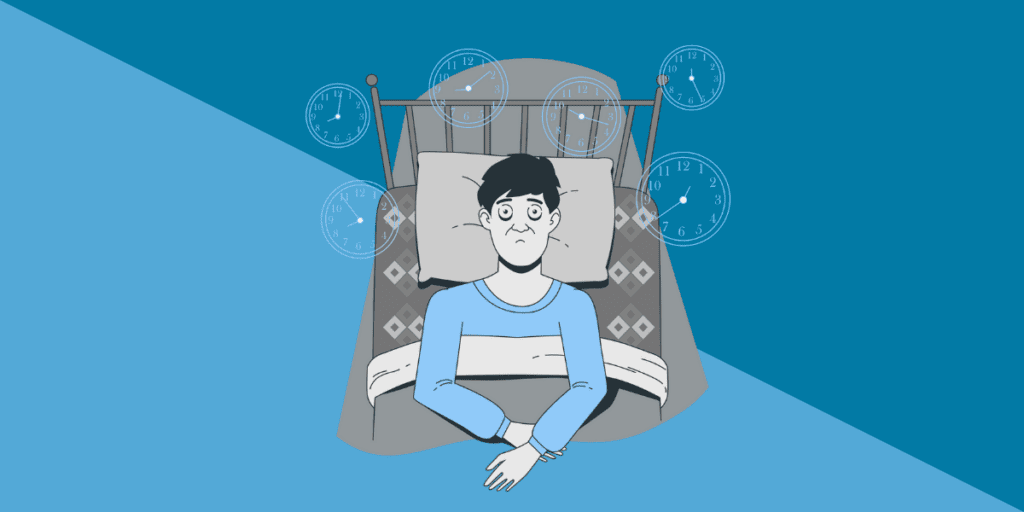Tired of staring at the ceiling and need ways to fall asleep quicker? Not only is it frustrating to lie awake, but late nights can hinder your performance the next day.
On top of daytime drowsiness, a lack of quality sleep can spur a multitude of negative health conditions.
For overall good health, researchers say sleep should be given the same amount of attention as exercise and nutrition.
However, sleep deprivation in modern times is a growing concern. People simply aren’t getting enough hours of sleep.
Like psychologist and sleep researcher, Cassandra Carlopio, says, “The world needs more well-rested, happy, creative, energized people!”
Thank goodness there are plenty of proven methods for dozing off quickly so you can enjoy all the sleep benefits.
Continue reading to learn the most effective methods for getting that deep sleep your mind and body desperately craves.
Try These 7 Foolproof Ways to Fall Asleep Quicker
If you’re having trouble falling asleep, you certainly aren’t alone. Insufficient sleep has been widespread in recent times and studies suggest it’s getting worse.
Consider adding these methods into your bedtime routine so you can avoid becoming a statistic in the growing sleep epidemic.
#1 – Have you tried progressive muscle relaxation?

Stressful experiences throughout the day can leave your muscles tense without you consciously realizing it.
Over time, the tension builds up, making it hard to relax at night.
By relieving the muscle tension, you’ll have a much easier time falling asleep.
This is where the progressive muscle relaxation technique comes in.
With progressive muscle relaxation, the goal is to reduce stress and anxiety — a known sleep deterrent — by relieving the buildup of muscle tension throughout the course of a busy day.
To do this, lay in a quiet place, free from distractions. You’ll actively tense your muscles followed by a controlled release.
For example, flex your bicep, hold the flex, then slowly let it go. Typically, you perform controlled breathing exercises throughout the process.
You repeat this routine throughout your body, tightening and releasing all the muscle groups one at a time. Start from your feet and work up.
#2 – Do you know the 4 7 8 breathing technique?
Deep breathing is a widely popular practice in meditation and yoga. In fact, it’s the foundation of these common wellness exercises.
Controlled breathing patterns help your body take in more oxygen which in turn promotes relaxation — a necessary component for falling asleep quicker and easier.
According to a recent study, intentional breathing practices, reduced both physiological and psychological stress levels in adults.
American doctor, Andrew Weil, took note of how breathing exercises can promote a relaxed state and so he developed the 4 7 8 breathing technique.
The technique is really simple. It’s easy to work into your routine just minutes before bed.
First, take a four-second long, deep breath. Next, hold the breath for seven seconds. At last, exhale for a total count of eight.
Repeat the sequence as necessary until deep relaxation washes over you at night.
#3 – How does paradoxical intention work?
If you feel anxious or worry that you won’t fall asleep, then paradoxical intention therapy may be the solution you’re looking for.
Introduced by renowned psychologist, Viktor Frankl, paradoxical intention works to alleviate sleep anxiety by actively trying to stay awake.
Someone who constantly struggles with insomnia typically worries about not being able to fall asleep when it’s time for bed. The more they focus on trying to sleep, the harder it becomes to fall asleep.
But what if you instead focused on staying awake? Will it have an equal and opposite effect from when you focus on falling asleep? The research is scarce, but it may very well work.
To fight off the worry and anxiety, paradoxical intention therapy tells the person to actively try and stay awake. It’s a counterintuitive approach to sleep worries.
When a person focuses on staying awake rather than worrying about falling asleep, the theory is that the anxiety surrounding insomnia may disappear.
#4 – What is the military relaxation technique?
If you’re having trouble dropping off, imagine a soldier trying to sleep with bombs and gunfire going off around them. Talk about an awful sleep environment.
The kicker is, soldiers operating heavy machinery and employing advanced tactics to defeat the enemy have to be on top of their game.
What’s the best way to be sharp and alert? A quality night of sleep.
This presents a conundrum, which is why the United States Military developed the ‘military method’ for relaxation.
The military relaxation technique is said to help you fall asleep in less than two minutes — even if you’re sitting up or recently had caffeine!
The military method for relaxation is so effective that it’s incorporated into training before deployment.
Here’s how it works.
First, relax the muscles in your face. Next, completely rest your shoulders, letting your hands fall to the side of your body like spaghetti.
Take a deep breath from your stomach, and on your exhale, relax your chest. Continue breathing in this way through the following steps.
Relax all your leg muscles.
Clear your mind by imagining a relaxing scene such as a pleasant sunset on a warm summer’s evening. Spend at least 10 seconds in this state.
If you can’t clear your mind, repeat the words, “don’t think”.
Stay this way until you fall asleep.
Now, you may be thinking, “Asleep in two minutes? Yeah right.” But it’s important to remember that in military training, soldiers are extremely disciplined and practice this routine every night for months before deployment.
So, it’s reasonable to believe that if you practice at home, you’ll also be able to reap the rewards of faster sleep by consistently practicing this method.
#5 – Are you lowering your body temperature enough?
Have you ever had issues sleeping on a hot summer’s night?
If the temperature in your sleeping environment isn’t just right, it may affect your body’s internal temperature and result in disrupted sleep.
Sleep onset is accompanied by your body’s steepest level of core temperature decline. In other words, when your body cools down, it’s conducive to falling asleep.
So, it makes sense that when your room is too hot, you’ll likely have trouble sleeping.
Professor of neuroscience and sleep expert, Matthew Walker, suggests the optimal temperature for your sleep environment is sixty-eight degrees Fahrenheit.
If you don’t have the means to control the temperature in your room, consider taking a warm bath before bed.
When you take a warm bath (or shower) blood flows to your extremities, reducing your internal body temperature.
#6 – Have you tried reducing blue light exposure?

Blue light exposure from devices like your cell phone, tablet, or television thwart your body’s natural production of melatonin, a sleep hormone.
When your body isn’t producing melatonin, you’ll likely have difficulty sleeping.
Reducing your blue light exposure in the hours before bedtime may help you fall asleep quicker.
It’s difficult to turn your focus away from devices in the modern world of technology.
Consider purchasing a pair of blue light glasses. They will block out the light which prevents melatonin production and help your body’s natural sleep cycle take effect.
#7 – What’s your bedtime routine like?
Taking a shower, drinking coffee, or exercising are all parts of a morning routine that can help you get fired up for the day. Your bedtime routine is equally significant for winding down and falling asleep at night.
Everyone wishes getting to dreamland were as simple as flipping a switch, but that’s not quite how it works.
Falling asleep is a natural bodily process that begins when the sun goes down. As light decreases, your body starts producing melatonin.
Just like an athlete preparing for a game so they can perform their best, people looking to fall asleep quicker need to have a bedtime routine that will promote healthy sleep.
Meditation, yoga, reading, or drinking chamomile tea are all healthy bedtime routines to help ease your mind at night in preparation for sleep.
It’s important to steer clear of activities that will increase your heart rate or expose your eyes to blue light.
Try and avoid intense exercise, action-packed movies, or video games in the hours before bedtime.
To Wrap It Up
Everyone wants to find ways to fall asleep quicker so they get a longer night of rest.
Unfortunately, there is no silver bullet when it comes to sleeping in seconds. But by consistently practicing proper sleep hygiene, you’ll give yourself the best opportunity to doze off promptly.
If you don’t think the suggested sleep strategies will work for you, don’t give up. There are plenty of other options to consider before turning to potentially harmful medications.
Consider trying one of these top natural remedies for falling asleep.

Welcome to Snoozerville! I’m Dr. Alex Hartley, your guide to the world of restful sleep. With a Ph.D. in Sleep Science and years of experience as a sleep therapist, I’ve dedicated my life to understanding and improving sleep quality. My passion lies in uncovering the mysteries of sleep and sharing practical, science-backed advice to help you achieve the best rest possible. Beyond my academic pursuits, I’m an advocate for mindfulness and relaxation techniques, which I incorporate into my daily routine. At Snoozerville, I aim to transform your nights, combining the latest research with easy-to-implement tips. Whether you’re a chronic insomniac or just looking to improve your sleep hygiene, join me on this journey towards peaceful, rejuvenating sleep.





